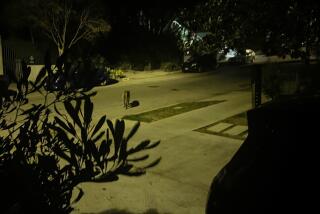L.A. Scene / The City Then and Now
- Share via
For almost 20 years, until it closed in December, 1942, Gay’s Lion Farm in El Monte served as the home for some of the most famous of felines--most notably Leo, MGM’s renowned movie lion.
On Monday nights, the only night of the week that the lions were not fed, residents in the peaceful countryside near the five-acre site could hear the beasts roar--what the neighbors affectionately referred to as the “Glee Club.”
The farm, located on a site east of Peck Road and north of Garvey Avenue, was owned by Charles and Muriel Gay. Their story began in London, where Charles was a star circus animal trainer and Muriel was a newspaper journalist. Soon after their marriage, Gay informed his bride that he had signed her up as a performer. Her co-stars would be leopards.
A few years after traveling to Los Angeles with the English circus, the Gays opened their lion farm on July 1, 1925, with 57 lions that were trained primarily for zoos, circuses and the motion picture industry. Gay charged his movie clients what was then a whopping $100-a-day training fee. By 1942, the number of lions had grown to 217.
More than a million visitors passed through Gay’s farm, among them Albert Einstein, Eleanor Roosevelt, and actress Marie Dressler, best remembered for her role in “Tugboat Annie.” A number of rare white lion cubs were born there, as were three sets of quintuplets. Lions Clubs held many banquets at the farm, featuring broiled and fried lion meat.
Charles Gay nearly lost his life in four incidents in which he was clawed by lions. Two other trainers did lose their lives while the Gays were in Paris. In one instance, the trainer was attacked after he stumbled during a show. In the other, the trainer was killed while transferring five lions from one cage to another.
On April 20, 1936, the Gays introduced a robot--looking much like the Tin Man from the “Wizard of Oz”--to take the place of a trainer. The robot gave orders for the lions to lie down and swung a heavy club with authority, only to have its power line chewed to pieces and its mechanical body furiously dismantled.
At one time, admission was 25 cents. And for $1, visitors could have their pictures taken with Numa, a giant lion, standing on his hind legs with forepaws on their shoulders, staring them in the face.
Numa and his cub, Peter, were also famous movie stars. They were used by various studios for jungle scenes and often filmed on the farm, surrounded by palms.
Many obstacles were overcome by the Gays: A lion choked to death on a piece of meat, another died of appendicitis and a third was killed in a fight.
With the onset of World War II, meat for the animals became scarce and gasoline rationing cut into tourism, forcing the farm to close.
Today, a McDonald’s is located where the entrance to the farm once stood. Leo is buried at Los Angeles Memorial Pet Cemetery in Calabasas. A male lion statue that once stood guard at the farm stands at El Monte High School.
But in its heyday, an advertising pamphlet placed in hotels and public buildings proclaimed: “To visit the great Southwest and not see Gay’s Lion Farm is like going to Egypt and not seeing the pyramids.”
More to Read
Sign up for Essential California
The most important California stories and recommendations in your inbox every morning.
You may occasionally receive promotional content from the Los Angeles Times.













